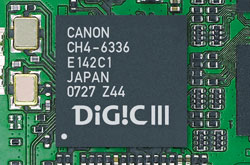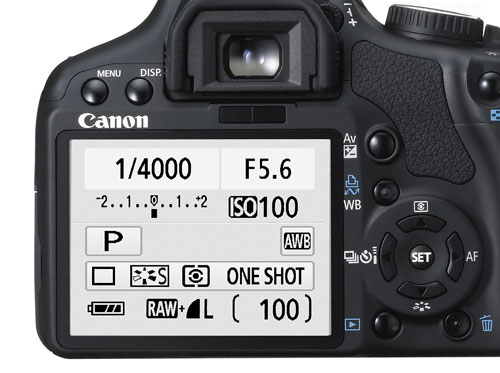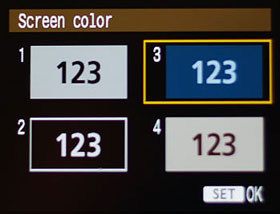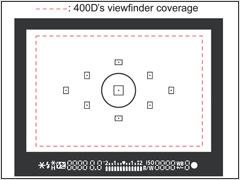Canon XSi: 12.2 Megapixels, Image Stabilized Lens, and Double Live View
by Wesley Fink on May 5, 2008 3:00 AM EST- Posted in
- Digital Camera
XSi Features
Some of the more significant improvements to the XSi were taken from the Canon 40D and the Pro Canons. The processing heart of the XSi is the Digic III which is the same chip used in the 40D.

This endows the Canon XSi with a speedy 14-bit Analog-to-Digital converter. Digic III was widely praised when it was first introduced last fall as dual Digic III processors in the $8000 EOS 1Ds Mark III and a single Digic III in the Canon 40D. Now the entry-level XSi has the same processor as these Canon top-line cameras.

The 3" LCD used on the XSi is the largest LCD currently used on an entry-level DSLR. Others are 2.7" and 2.5". This is also the same 230,000 pixel 3" LCD used on the 40D and the 1Ds Mark III. This is not as finely detailed as the higher-resolution 3" LCD used on the Nikon D300 and the Sony A700, but those are $1800 and $1400 cameras compared to $800 for the XSi body alone. The 3" display can even be customized by choosing one of four color schemes.

Our review of the Sony A350 complained about the horrible .74x magnification and "looking down a tunnel" view of the A350. All of the cropped sensor cameras (i.e. most everything but top Pro DSLRs) are challenged in producing large, bright viewfinders compared to 35mm full-frame cameras.

Canon continues to improve viewfinders - even those in their entry XSi camera. Here you can see the improved view of the .87x magnification XSi compared to the .80x magnification of the XTi and XT viewfinders. The original Digital Rebel from 2003 featured a decent .88x viewfinder that was sacrificed to the size shrink of the Digital Rebel XT model. With the XSi the viewfinder of the entry Canon is back to the magnification of the original Digital Rebel. Brightness also appears to be improved with the XSi the brightest finder of the series.
While the .88x is a welcomed improvement, the new 40D prosumer model has an even better viewfinder with a .95x view. Since the 40D and XSi sensors are the same size (22.2x14.8mm), the viewfinder magnifications are directly comparable. However, comparing the XSi viewfinder to its competitors - the Nikon D60, Sony A350/A300, and Olympus E-510/E-420 - shows the Canon XSi to have the best viewfinder in its class.
The 9-point AF module appears similar to the 9-point AF in the Canon 40D. Working range AF specifications are the same EV range of -0.5EV to 18EV. However, the 40D adds an additional diagonal cross-type sensor with greater precision for f2.8 lenses, providing better support for fast Canon L lenses.
The XSi is the first in the Digital Rebel series to feature a Spot Metering option. Every review has complained about this missing feature since the launch of the original Digital Rebel, and Canon has finally listened. The spot meter is 4% of the viewfinder and available only on the center spot. In the picture above showing the viewfinder, the spot metering area is represented by the circle around the center AF spot. This is also visible in the XSi viewfinder.
ISO Speed Display and Auto ISO
Users have also asked Canon to add ISO speed to the viewfinder display. In the XSi that is finally a reality. Auto ISO is also a more useful feature since it now works over a wider range, at least to 800 in our tests and the auto-selected ISO is also displayed in the viewfinder and on the rear LCD dynamically. However, even in total darkness we could not coax Auto ISO to select 1600, and in the brightest of shooting situations the XSi would not auto select ISO 100.










56 Comments
View All Comments
meanjean - Wednesday, September 3, 2008 - link
Anyone had trouble with memory cards not recording pictures because of being dislodged from contact points for some reason?thepieces - Saturday, May 10, 2008 - link
Cool review, but the samples are horrible. A little more effort than images from your back yard please :) Half of which are out of focusMidwayman - Friday, May 9, 2008 - link
"Early testing shows the new 18-55mm IS to be a superb lens with performance comparable to top-line Canon lenses."So you're saying the kit lens is up to L quality. Right.
Also that Nvidia test target you are using is really a pretty poor choice. Almost no fine detail. Noise is only have the story when comparing high iso. You also need to look at detail retention. The only thing that could possibly qualify is the TM. Alot of camera that appear to have low noise do it through destroying detail.
I know a couple other folks have mentioned the lighting. You're doing all this in a low light setting. What about outdoors? People take an awful lot of pictures outside. I know you complain about "studio lighting" but since you can't control outside conditions, at least you can bring the light level up to a reasonable level. For under a $100 you can pick up some work lights at home depot and a couple yards of white muslin to make a large softbox. Test shots are test shots and I'd rather see them at more normal exposures. (and then you can stop down to f8 to get max resolution)
m61376 - Friday, May 9, 2008 - link
I have been trying to decide between the D60 and the XSi for several days, reading everything I could find. The two stores I went to were very Nikon biased. This is one of the best comparative articles for a newbie to digital SLR, upgrading from a point and shoot.I appreciate the XSi comparison to the D60 rather than the D80. I think there are many people like me who are reticent to upgrade to the SLR's because of their size and the larger size and weight of the D80 and the like just take it out of consideration.
iamatrix - Friday, May 9, 2008 - link
Looking at samples from the D60 and Rebel, the D60 images at high ISO look better - better contrast, color rendition, and noise handeling. Canon suffers from high ISO chroma noise, which has been noted by dpreview time and time again, Nikon on the other hand has higher luminance noise. Chroma noise is much harder to deal with in the post processing stage and leaves a blotchy 'digital' look to high ISO images whereas the Nikon grain is more film like and easier to deal with using noise reduction software.Deadtrees - Thursday, May 8, 2008 - link
Though many reviewers and users have been complaining about Canon's yellowish WB under tungsten light, it is, in fact, Canon's policy to keep it that way.It's true that there're times when I want the pictures to look yellowish as it captures the mood of the scene such as in Cafe and restaurant. But at the same time, there're times when I want the pictures to look not yellowish at all.
Having said that, I understand where they're coming from and why they decide to keep it that way. However, it'd be much better if Canon, at least, gives two options in that situation: #1 for true to the eye, yellowish WB. #2 for absolute WB.
Sure, I get around with this 'problem' by having 3 slightly different tungten lighted gray card pictures in the memory card and using them accordingly. It pretty much solves the 'problem' but having that option built-in would be just better and eaiser.
I tried to find the link of the interview talking about this issue but failed. It was an interview done by a Japanese camera magazine with the president of Canon camera. If anyone has the link, providing would be more than greatful.
mikett - Wednesday, May 7, 2008 - link
I meant the shutterbox as the external construction is obvious.Wesley Fink - Wednesday, May 7, 2008 - link
Canon rates the 40D shutter for 100,000 actuations. We can not find a published spec for the XSi (450D) shutter, but it is presumably less than 100,000. The XSi shutter is more likely designed for 50,000 acttuations.punchkin - Wednesday, May 7, 2008 - link
You're talking out of your a**. There's no reason for such a claim.Wesley Fink - Thursday, May 8, 2008 - link
Actually there is a reason. As stated we could not find a spec for the rated shutter life of the XSi, but the 40D does have a specified rated life of 100,000. However a few other entry SLRs have a rated shutter life of 50,000 actuations, and we would expect the XSi to be competitive. That is an assumption and not a hard fact.The rated life for the Olympus E-3 is 150,000 shutter actuations and is specified, but many DSLRs do not specify a rated shutter life.